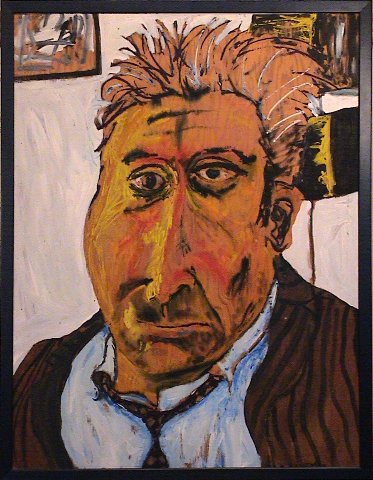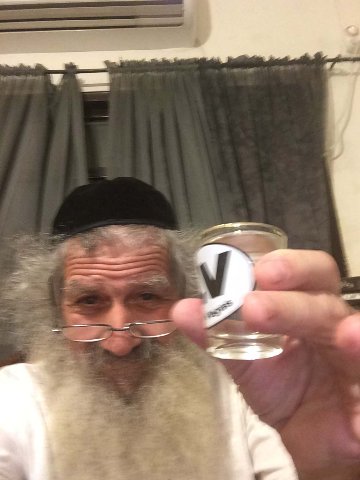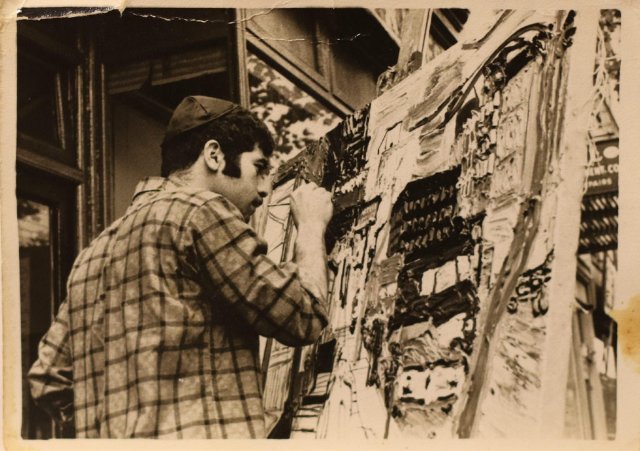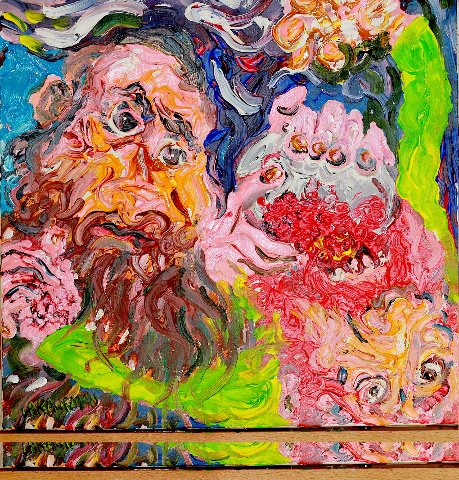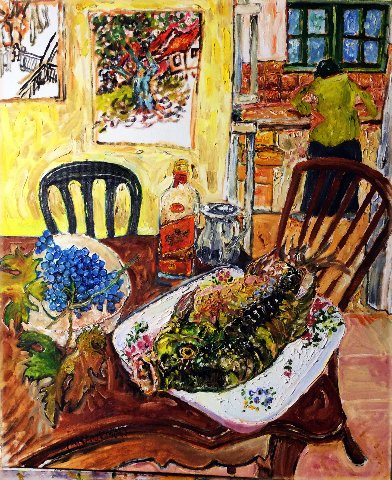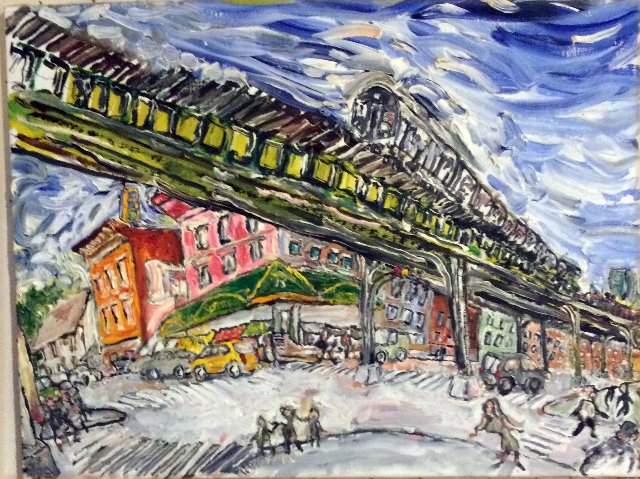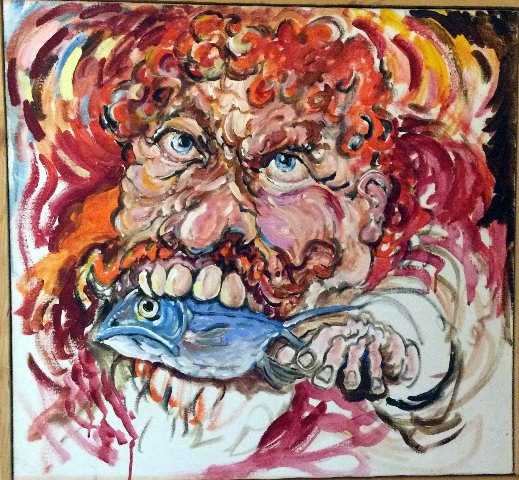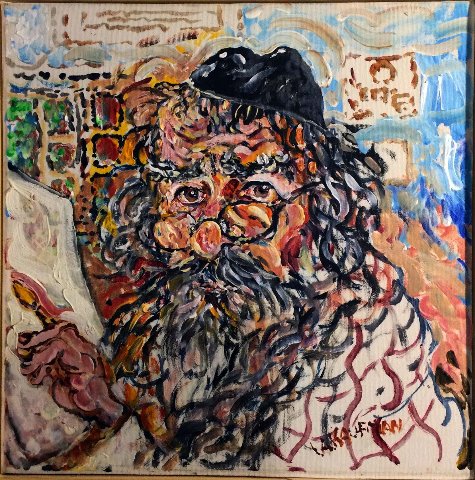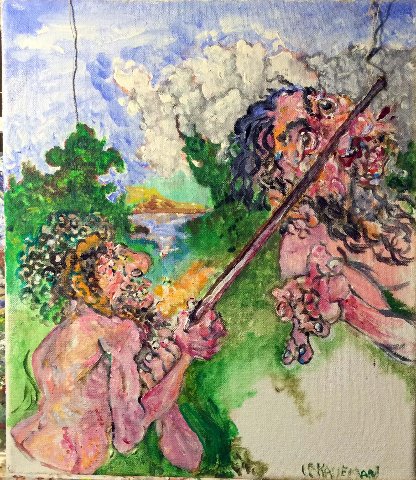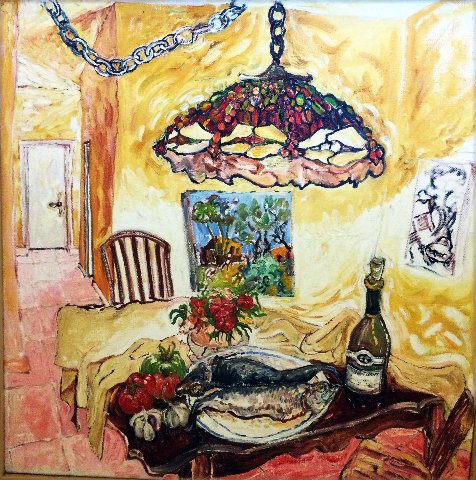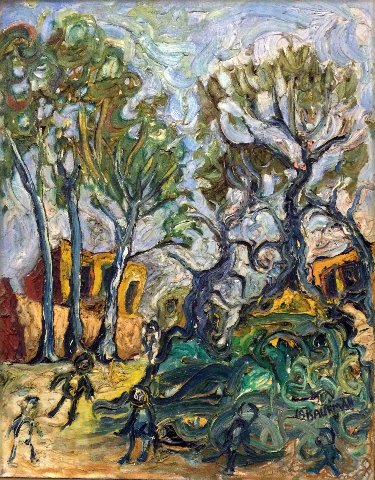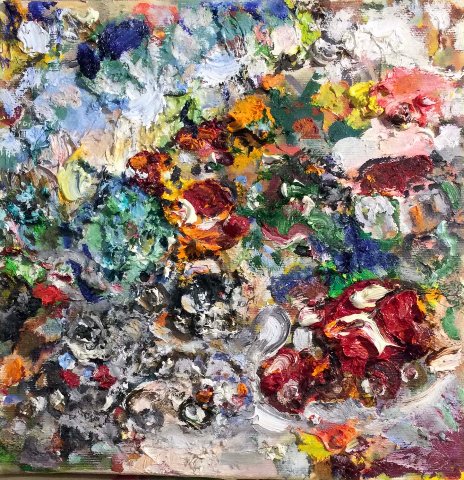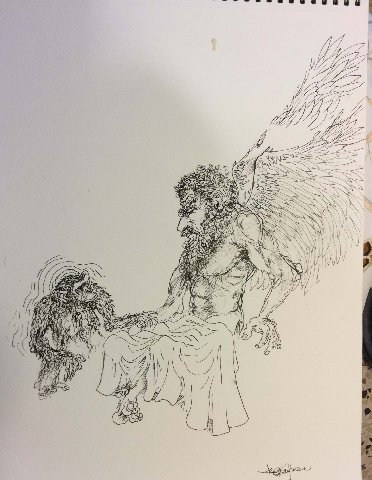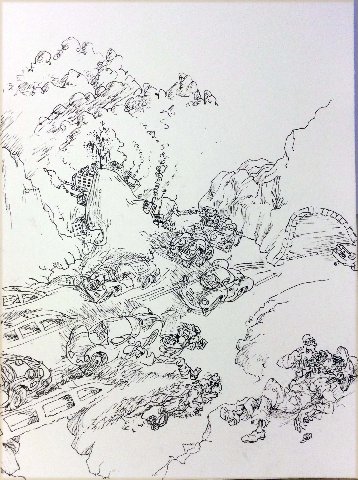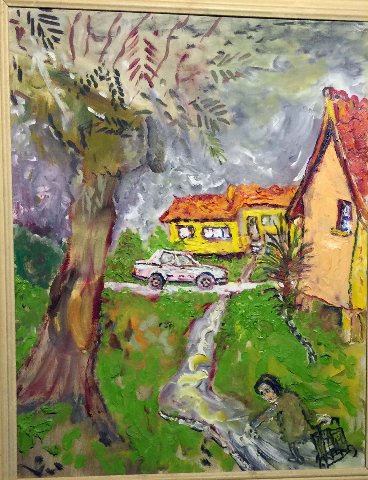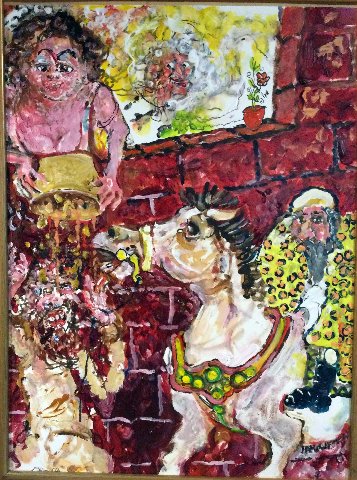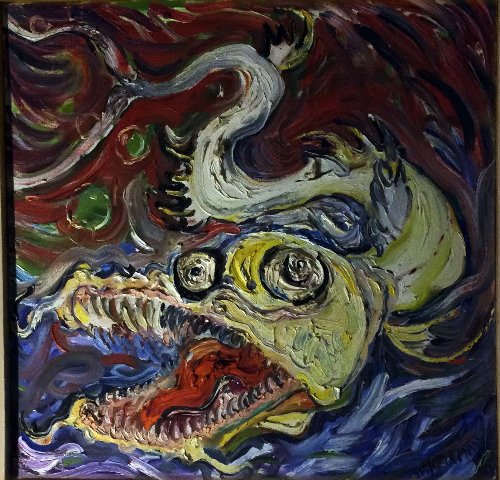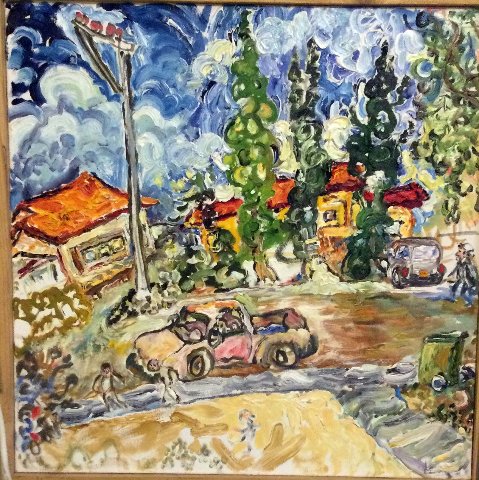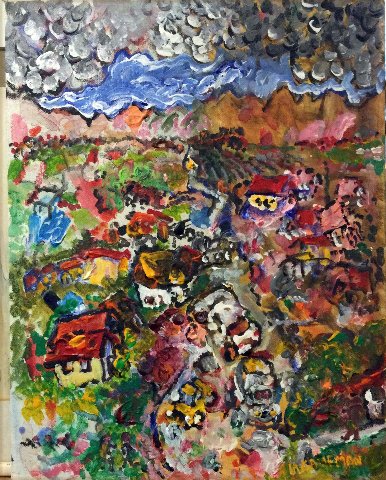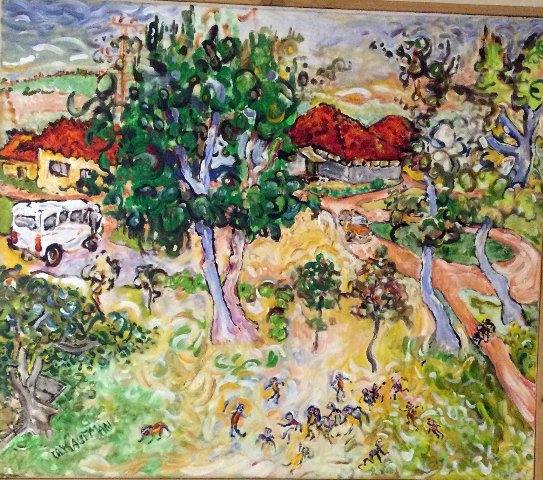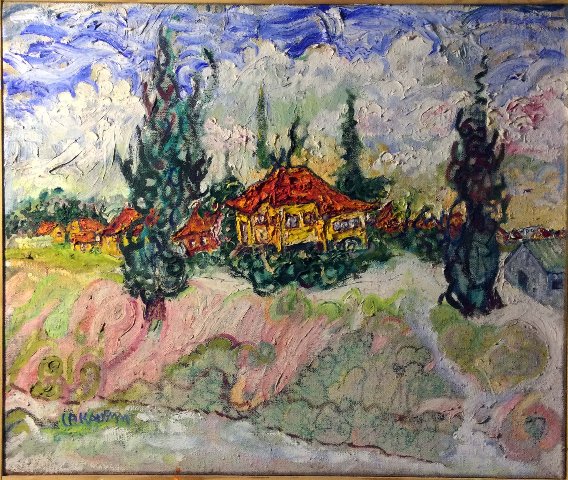Israeli Expressionist Artist Ira Kaufman
Was Director of Historic Brata Gallery in New York
By: Charles Giuliano - Jul 21, 2022
Out of the blue I got a call from Ira Kaufman in Israel. The name was vaguely familiar but didn’t click until he said “It’s me from The Brata Gallery.” Then it all locked in.
During the mid-1960s I lived at 330 East 11th street in the Lower East side. I had a storefront space which functioned as a studio. Using acrylic paint I was creating hard edge paintings using masking tape to create large flat areas. It was interesting work which I left behind and never resumed when I went on the road with Arden Harrison bound for Mexico but ending up in New Orleans. Then back to Boston for the summer of 1968 as managing editor of Avatar.
When passing by I always hung with Ira at the spacious Brata. It was a cooperative gallery which also functioned as his studio. He put on the lights when potential customers visited. In the basement he operated a frame shop and built stretchers for artists. I bought them from him having no such ability for fabrication.
They were interesting paintings which I exhibited as part of the First International Psychedelic Art Fair held at the Forest Hills Tennis Club. An abstracted rendering in hard edge of The Pyramids was stolen from event.
Ira put me in a couple of Brata group shows. I also was in a show at Max’s Kansas City juried by Marcia Tucker the founder of the New Museum. I also had a psychedelic drawing in the Penthouse of the Museum of Modern Art which was their loan collection.
Those dreams of making it in the art world never happened. I have always wondered what might have been had I remained in New York just when things were beginning. I curated the first psychedelic exhibition The Visionaries for East Hampton Gallery. It got a slam dunk of media coverage and was the basis of the Grove Press book "Psychedelic Art." I also arranged for a Moondog concert at Spectrum Gallery after which he emerged from cult figure to mainstream.
After three adventurous years I was out of New York by 1968. Ira left for Israel in 1970 where he still resides. There was much to catch up with. Immediately we connected as funky hipsters with stories and humor to share. As we spoke I vividly recalled his unique Orthodox Jewish schleppy persona. With a stooped shuffle pace he seemed old then though in fact young. There was the aura of rabinnical wisdom as he had a quote, shrug or anecdote for everything. He spoke volumes with body language which by phone and e mail I may only imagine. Judging from a photo he sent today, indeed, an alter koker but a few years my junior.
Brata was one of the last of the Downtown Galleries of Tenth Street. During the emergence of the Post War New York School it was where artists had studios and showed in cooperative galleries.
Some of the most well-known galleries that made the area what it was were: the Tanager Gallery, The March Gallery, The Hansa Gallery, The Brata Gallery, The James Gallery, The Phoenix Gallery, The Camino Gallery, and the Area Gallery. Although the 10th Street galleries have almost all closed, the Phoenix Gallery remains albeit in a new location and with a new membership. Other galleries associated with the area and the time were the Fleischman Gallery, the Nonagon Gallery, the Reuben Gallery, the Terrain Gallery and the gallery at the Judson Church, which were not co-operatives.
In the fall of 1949, a group of Abstract Expressionists fixed up a third-floor loft at 39 East 8th Street. In the months that followed, the loft, which came to be known as “the Club,” evolved into a center of the New York art world and the lives of Village artists.
Some of those counted as among the Club’s founding members were Conrad Marca-Relli, Franz Kline, Joop Sanders, Milton Resnick, Giorgio Cavallon, Ibram Lassaw, Lutz Sanders, James Brooks, Willem deKoooning, Lewin Alcopley, Philip Pavia, Frederick Kiesler, John Ferren, Jack Tworkov, Landes Lewitin, and James Rosati.
The critic and art historian Irving Sandler discussed with me his stint as manager of the club. He started taking notes and visiting studios. That led to his seminal book "The Triumph of American Art."
As part of research for a retrospective by Lester Johnson at the Westmoreland Museum of Art he recalled holding his own as the only non abstract artist member of The Club. One of the prevailing topics of panel discussions was “The Return to the Figure.” Bill Seitz mostly got it wrong with his New Images of Man for MoMA.
Lester was a part of the Figurative Expressionism movement which never got the time of day from the art world establishment. It was kicked to the curb by the simultaneous emergence of Pop art. Coming out of Lester, Jan Muller, and Bob Thompson of Figurative Expressionism was a vibrant next generation of expressionists known a Rhino Horn. They too were shunned by the mainstream art world and only now are coming to be recognized. Adam Zucker is the leading scholar of figurative expressionism and Rhino Horn.
I recall Ira’s aggressive figuration now updated by images he sent to me. It seems that he was allied with Rhino Horn and I had questions about that as well as the downtown art scene of Brata in the late 1960s.
Ira Kaufman There was an article posted about me by Jonathan Hemley which you might check out. https://www.galleryand.studio/2021/12/14/seeing-the-world-like-ira-kaufman/
Charles Giuliano The images you sent to me vividly recall what you were paintings during the Brata days. What do you relate of the demise of the Downtown scene?
IK Obviously you have eyes. True as rain I'm still me. So, as I see, you are still you.
Exactly what you said. It was the tail end of the 'New York School' if there ever was such a thing. 3rd generation riding off, and no one to squeak "come back Shane". What seemed to doom the creativity was the 'market'.
I was talking to Winograd in the Brata once and we agreed it had turned into a supermarket. Today? More like a junkfood fastfood joint.
Bill DeK (Willem deKooning) had the studio upstairs (from Brata Gallery). Joan Ward lived there. Harry Kerwin owned the building as well as McSorley's old alehouse on 5th. He was a nice old Irish gentleman, & tough. He told me Bill kept her upstairs cause everyone had to keep his (slang for mistress) somewhere. LOLOL. If I remember correctly the address was 56 Third Avenue.
CG Tell me about artists with studios near you.
IK Here's an interesting story I had with Joan. Nothing sexual , but perhaps Freud would disagree. One evening when I had a show hanging Joan comes in smashed gone baby. She staggers around ,and starts yelling " Ira you (anti-Semitic screed)." After exhausting her (rant) she staggers upstairs. Next day she comes into the gallery, as sweet as you please. Looking like an ambassador. "Ira I have this special frame I use when I do portraits,” she said. "I thought perhaps you could use it as you do such nice portraits." Of course I thanked her very much. Indeed.
(Joan Ward-Summers was born in Akron, Ohio on April 18, 1934-1998). She received her artistic education from four schools in the United States including RISD. She made brightly-colored tapestries.)
CG From the article on you I was surprised to learn that you were married at 19. How did you manage to keep the family together as a young Orthodox Jewish artist?
IK I'm inclined to keep my privacy as that was also always important. Yes I'm still married to the same woman for over 60 years. Our oldest is himself well over 50. Our second child, our daughter, passed away a few years ago, but not before she held her grandchildren. We had 3 more here and we have grandchildren, great grandchildren, & maybe soon... We have a tradition that if you live to see your great great grandchildren you will not see the gates of hell. So you're free to do anything. I ask you what on earth kind of sin are you capable of at this age? Which brings to mind an Arab saying. Allah gives walnuts to the toothless.
CG You were living at Brata. I assume that was rent free.
IK The gallery was not free. I mentioned Mr. Kerwin the landlord. He was very nice fellow, but he was no fool. We had an apartment on 10th street.
CG What do you recall of the 10th Street galleries?
IK When I first took canvasses to the 10th street galleries there were, as I remember, between 9-11 of them. I applied to each one in turn, and was refused. I left the Brata for last as I considered it the best, therefore I'd have the least chance, and amazingly they accepted me.
(By one vote) John Krushenick (with his brother, co-founder of Brata) told me, and he was delighted by that. I didn't realize the importance of controversy. He did. I'll tell you a bit about John later on.
By the way, there was one of the 10th street galleries which was a private affair, not a co op. The owner, a certain woman who, when things were going for me pretty good, came in and apologized for not accepting me. Funny what you remember. Actually one artist who had a show there of very nice works though very invovlicated ( made that word up) who was Italian, or Spanish. I couldn't tell from his name or his accent. Some famous designer’s name he had. He came in drunk and started berating me on my subject matter. WTF. His friend had to drag him out. I am an Alfa Romeo Alfisti, & I think his family had something in car design in the old days. LOL. When people hear the word Alfisti I guess they think it has to do with some nasty act.
CG What more can you tell me about your neighbor Joan Ward?
IK Ah! Joan Ward. I mentioned her drunken rant. Well we don't hold what people say against them when they're drunk. Only property damage, & there was none of that.
What I did observe was Joan, and Elaine (deKooning) were physically similar. We artists notice things like that, as you know. Elaine I felt was a lady. Joan would not have that noun.
I could venture perhaps she would do for Bill what Elaine would not. Elaine's mother was mentally ill. Perhaps that's why Elaine would not consider having a child. Sad. Joan is mentioned a few times in "Tenth Street Woman."
(In fact Kaufman is referencing “Ninth Street Women: Lee Krasner, Elaine de Kooning, Grace Hartigan, Joan Mitchell, and Helen Frankenthaler: Five Painters and the Movement That Changed Modern Art” Hardcover – September 1, 2017 by Mary Gabriel. Reviews: "A gorgeous and unsettling narrative...Ninth Street Women is supremely gratifying, generous, and lush but also tough and precise -- in other words, as complicated and capacious as the lives it depicts...It's as if once Gabriel got started, the canvas before her opened up new vistas. We should be grateful she yielded to its possibilities."?Jennifer Szalai, New York Times. "Ninth Street Women is like a great, sprawling Russian novel, filled with memorable characters and sharply etched scenes. It's no mean feat to breathe life into five very different and very brave women, none of whom gave a whit about conventional mores. But Ms. Gabriel fleshes out her portraits with intimate details, astute analyses of the art and good old-fashioned storytelling."?Ann Landi, Wall Street Journal
("Ninth Street Women is a must read...Gabriel seamlessly weaves the intimate and the public, the lives and the art, making us feel we were there...It is a story that is a part of the American story, told here in vivid, meaningful detail, an absolutely pivotal text."?Margaret Randall, Women's Review of Books "Gabriel's fascinating group portrait shimmers with vivid personal detail...She traces their interwoven paths from studio to Cedar Bar to the Eight Street loft known as the Club...Over time, Willem de Kooning outshone Elaine; Jackson Pollock eclipsed Krasner. Key contributions were erased...Gabriel makes sure these major artists who have been written out of history are not forgotten."?Jane Ciabattari, BBC.com)
I've never seen Ward’s work. Just now googled her, and there's a very nice painting of a bed, windows and a dresser. She always called herself Mrs. deKooning, and would always say "my husband Bill" out loud. Whatever.
CG Did you know Joan Mitchell?
IK I lived on St. Mark’s place as a teenager when I got out of the Airforce...Honorable discharge. I have it. There's a story there, but I won't go into it.
Joan Mitchell lived on the top floor. I was told by the super that she got a license to break open the back wall to remove a painting. I never met her then. I wouldn't have known her if she passed in the hall.
Elaine did get on our case before we left the country (in 1970). First she invited us to a party with everybody, but we're Shabbos observers, & couldn't go. Before we could get to another one, not on Friday evening, we were on the plane for Israel.
Elaine sent Jamie Wyeth to meet me. He didn't have any praise to say for his father’s paintings, but he ended painting in the same style. Strange. Elaine bought several works from me. A water color with impasto, and a drawing as I remember. She did a portrait of me in her studio on Broadway.
She came to the Brata where I was doing a portrait of her. Who walks in as I'm painting, but my uncle Alex. Now old uncle Alex has this white hair jutting out like Ben Gurion, and he holds the family Passover Seder. I see him as a conservative solid old gentleman. Now he's about 70. He looks at the portrait I'm doing and says "What are you doing making that beautiful young lady so ugly?"
I'm like, I'll be a lop ear'd mule . The old fellow is hitting on Elaine. I never knew he's a swinger.
Elaine was 'the' mover. She was trying to get me into an uptown gallery but that never happened. I really didn't know Bill that well. If we'd stayed I guess we'd of been in the fray. I regret nothing.
CG Tell me more about Brata co-founder Nicholas Krushenick (May 31, 1929 - February 5, 1999). It seemed that during the late 1960s he was popular for an abstracted version of Pop.
IK Yes, Nick was hitting it big. Was it op art he was doing? Names of schools are so vague. Your bright colored painting you sent me reminds me a bit of his style. He had a big show uptown, and the star painting was called "Pussy Galore on a Sunday Afternoon." I'd meet him now and then. His brother John was more of the earth. They together had started the Brata gallery. Brata of course means brother.
When I joined John was running the shop in the back and manager of the gallery if some one came in and was interested in a painting. John was an excellent craftsman and taught a course at Cooper Union on the subject. Now it was the winter before the transit strike when Lindsey was to become mayor. Everyone received a letter for an emergency meeting. John could not continue. Ways and means were in order to save the gallery.
I looked at my wife and said I think I can take this as an opportunity. I was then 21 or 22 working for an outfit named Thabit. Nice folks Marano Christian Arabs from Lebanon. They had about 12 rental room houses. I was the handyman and the guy who got the other workers out of trouble when they got stuck. I did plumbing, plaster, painting and electrical work. That's why I figured I could do what John did.
They were nice folks it was fun, but didn't pay much. I'd make a budget once a month from my salary then jump down to Bush Terminal (now Industry City) and next shoot up to Utrecht Linens to buy supplies. I used my living room as a studio.
We had the meeting and the situation was John could not continue. Chins were on the floor. They had advertised in the Voice and the Times for someone to take over the gallery with no takers. I was the youngest there. When I found it appropriate to speak, I announced I would like to take John’s place. The room changed mood and they asked a few questions. I answered and was accepted.
I informed my boss I would finish the month and work half a day the following month, as John would instruct me that month. Each day I'd take the subway to the city and John would go thru a few pointers. Then he'd send me around the corner to the liquor store to buy a bottle of Southern Comfort. He'd take a shot then give a few pointers. Take another shot, and give a few pointers. Take another shot. By then the pointers started to get blurry. I started to see why he couldn't continue.
CG At the gallery I met the beat poet Jack Micheline who was crashing there. He was a street character practically a hobo. He hung around with artists and got boozed at openings. He gave me a book that I admired and we printed one of his short stories in Avatar.
IK I’ll send you a portrait I did of him.
CG What was your relation to the Rhino Horn artists? The Boston collector Leonard Lewis is one of the few to pursue them.
IK When I took over the Brata and had a show of my work hanging. A fellow artist by the name of Isser Arronovici came in and introduced himself. He was one of the members of the Rhino Horn which had finished just a while before. He told me his work was with feelings of the macabre and the subject matter as well. He told me while looking at a painting I had hanging of a building in Brooklyn that it had the same feeling. Of course there was nothing macabre except the feeling.
Francis Criss gave me a similar critique when I had his painting class in School of Visual Arts. I really didn't know at the time who Criss was and what a complement I'd received. I was painting an old man he had sitting as a model. As he made the rounds and saw what I was doing he got excited and told me "stop, stop. Don't touch it anymore.” Of course I kept painting as I was in the part of life called the jackass years.
(Francis Hyman Criss (1901 - 1973) is associated with the American Precisionists like Charles Demuth and his friend Charles Sheeler. He was born in London and immigrated with his family at age four. He attended the Pennsylvania Academy of the Fine Arts from 1917 to 1921 on a scholarship, and later the Art Students League of New York.)
So me and Isser became great friends. He introduced me to Peter Dean. His work was also Expressionism and I grooved on it. I think Jay Milder, who I make sure to visit when I'm in New York, introduced me to Emilio Cruz . I visited Emilio a couple years before he passed, in his studio on Broadway. We had an interesting discussion on tribalism. He said he was trying to grasp with his work tribalism. I said you have aunts, uncles, cousins, sisters, brothers. Yeah. I said well on happy or sad occasions do you all get together. Yeah. I said that's tribalism. He got excited. "NO, NO". LOL. Guess he was looking for a cannibal feeling? His wife was there. Nice woman. I don't remember her name.
(Emilio Antonio Cruz, Jr. was born in the Bronx 1938 and died in 2004. He studied art at the Art Students League and the New School for Social Research in New York. I included him in the exhibition “Kind of Blue: Benny Andrews, Emilio Cruz, Earle Pilgrim and Bob Thompson” for the Provincetown Art Association and Museum. One of the works by Cruz in that show was acquired by the Museum of Rhode Island School of Design where his troupe was invited to perform.)
Ed Karafa came with Isser sometimes. And of course John Hoffa who went into composing modern music. I'm sorry but maybe it was good. It's probably me as I haven't been able to sit through a work by Mahler. I do love Mozart, Beethoven, Bach, Chopin, Tchaikovsky, Handel, Rossini et all, so maybe it ain't me. Yeah, why not be ecletic? Screamin Jay Hawkins, Professor Longhair, Little Richard, Dylan, Elvis. Hassidic music, chozenute, opera. I love it all.
So those guys were some of the Rhino Horn artists. Peter Dean, Isser and I felt our works were similar. I can say it most likely represents a stream of Expressionism. My aunt had taken me to museums when I was a child. I gravitated to Expressionism long before I knew what it was. I experimented and my abstracts made an impression on people who saw them, but didn't communicate to myself that it was enough. I was not achieving my potential I felt. I can stand looking at a work. If I smile cause it hits me like that I know I've been a sort of conduit of something pository.
I consider Chaim Soutine to be the best plastic creator of oil paintings of the 20th century. I didn't recognize his genius till I was in my forties. Then it took me years to understand he was above just about everyone in so many points no one came close. I'm not a bad artist. I think I'm a good artist. But Chaim! Wow. He came from a small village in Belarus which was the next village from were my folks came from. I found that out recently. For me, the great ones are Rembrandt, Vincent and Chaim. There were many great artists of course. We can name names but these three stand alone for a different accomplishment.
I spoke to Chaim's nephew here in Israel and worked a bit with his nephew’s daughter. She works at the Toyota dealership. The owner is a friend of mine and calls me when he has a classic Alfa Romeo to figure out.
It’s a small world. Isser took his own life; insanity for sure. Peter died not much later of Lou Gherig's disease.
CG From my early exhibition at Seymour Swetzoff gallery in Cambridge I sold a bunch of psychedelic drawings. With the money I bought a second hand Alfa Romeo Giulietta Sprint. It was a cool car but temperamental. It refused to work in the rain and I couldn’t afford to fix it. When I went to grad school it was repossessed when I stopped payments.
IK Now you're talking. I needed a car here in Israel and when I saw how inexpensive Alfas were I bought an Alfasud. You never got them in the states. When the head gasket went I decided to fix it myself. Alfa people seem to know Alfa people so guys with head gasket problems started to come to me to do their work. I graduated to Alfettas, then Giulia coupe, & all kinds of Alfas after that. I could have gotten your Sprint running in the rain. Had a Milano Verde in the states and imported a GTV6 to Israel. I worked with Giuseppi Leroe on that car. His garage is in the Bronx. Alfa Imports. Unfortunately, she caught fire and ended her life. I can't afford one of those new Giulias. The top of the line uses a Ferrari motor. My take is certain designs by people like Scaglione, Giugiaro, Farina and others deserve a place the world of art. No doubt my taste is eclectic.
CG What is the role of Judaism in your life and work?
IK I’m Breslaver Chasid, a faith that believes in serving God with the sincerity of the heart, with much joy, and living life as intensely as possible. This is evident in my paintings and drawings which are also inspired by the streets of Brooklyn, the towns and countryside of Israel, and stories found in the Torah.
CG Anything else?
IK
(Ira was born in 1943 and grew up in Bensonhurst, Brooklyn. His parents were Dora and Jack Kaufman, both originally from Belarus. Dora was a manager at a “zipper hospital”, and died from leukemia when Ira was seven. Jack was a letter carrier who died from heart problems when Ira was seventeen. He delivered mail to the arts district of Chelsea. Kaufman theorizes that art talent was transferred to him from the mail. After his father’s death, he lived with his Aunt Ann who was a hobby painter and encouraged his talent, taking him often to art museums. However, she thought he should also be practical and go into commercial art. This ran counter to Kaufman’s instinct.
Kaufman took little interest in school and would draw all day. He later enrolled in the School of Visual Arts. After graduating he got married at 19 and went to work as a handyman. However, all his free time was spent painting. He bought high quality paints and turned his living room into a studio. When it came to the point where Ira was happy with his work, he decided to look for an outlet to display and sell his paintings.)
Artists at the Brata Gallery had one solo show per year and Kaufman had his first in 1965. He was shocked that his art sold. His work was favorably reviewed by Ted Berrigan of ARTnews. “…a hip primitive with two eyes for color. His large assertive canvases acknowledge, Munch, Cézanne and Rousseau while boldly stating à la Henry Miller, ‘I’m from Brooklyn!’ ” Another solo show the following year was reviewed by Peter Schjeldahl of ARTnews. “…Best is his Pan-goat in a meadow by a stream, the paint slapped, slashed.” Ira showed with Allan Stone Gallery, and with John Hoffa, one of the founding members of the Rhino Horn group.
The exchange of e mails continued for several weeks. No doubt there is more to be said. I am delighted to have this narrative. I am sure it will be of great interest to colleagues, artists and scholars. Ira has been a vibrant presence in the art of our time.

